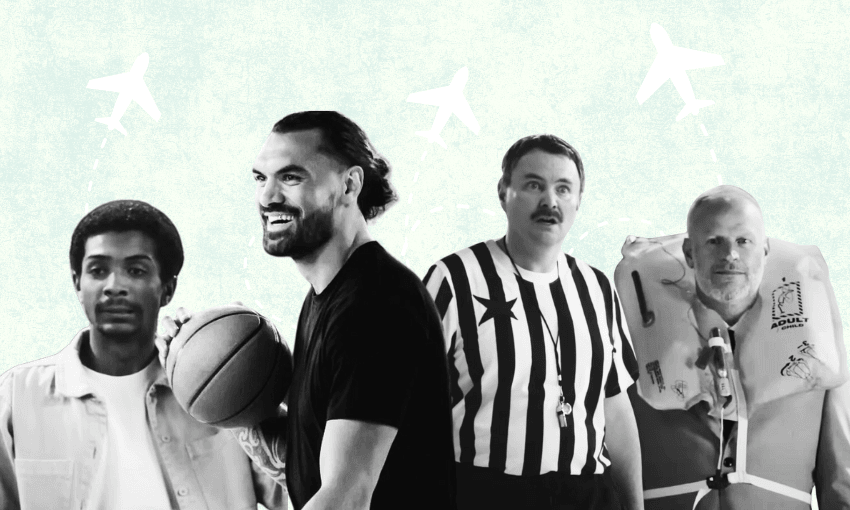Air New Zealand’s latest safety video, featuring Steven Adams and a cast of local stars, would have been expensive. That money could be better spent improving services, lowering fares, or reinstating cut routes, argues Liam Rātana.
Sigh. Another year, another tiresome Air New Zealand safety video that probably cost way too much money to produce. The latest edition features New Zealand NBA star Steven Adams, with cameo appearances from his Olympian sister Valerie, TikTok personality Theo Shakes, comedian Tom Sainsbury and sports broadcaster Andrew Mulligan. It might not be an all-star line up of Sports Illustrated models, Betty White, Katie Holmes or Richard Simmons, but it still would’ve cost a pretty penny. An NBA player earning tens of millions of dollars would not appear in a commercial ad voluntarily.
Air New Zealand has received much unwanted negative press in recent months over what many deem to be unnecessarily high fares, especially on routes it effectively has a monopoly over. The fares are considered so high that Air NZ sales (just your regular company sale) are frequently written up as news by media outlets. While the airline has repeatedly pointed the finger at Auckland Airport, and vice-versa, consumers continue to pay up to 300% more for some routes than five years ago.
But not all routes because some don’t even exist any more. In 2015, the airline controversially scrapped its services from Kaitāia, Whakatāne, and Westport, leaving those relying on their services to travel up to an extra three hours for flights. Just last month, the airline announced it would be scaling back its domestic services yet again, reducing capacity on three domestic routes and making schedule changes to others, including Queenstown, Christchurch, Wellington, Dunedin, Blenheim, and New Plymouth. It also announced it would be ceasing direct flights between Wellington and Invercargill next January.
In August, Air New Zealand reported a significant 65% drop in net profit after tax to $146 million, citing reduced domestic demand, rising costs, and operational challenges such as aircraft maintenance issues and competition on routes to the United States. Which came first, the reduced demand chicken or the exorbitant fares egg? Despite revenue growth, the airline still faced ongoing headwinds and was investing heavily in upgrading its fleet of aeroplanes to meet future needs.
Whatever the case, all that is to say it’s surprising to see the flashy, expensive safety videos continuing no matter the economic climate. Air New Zealand hasn’t released the true costs of the video, but given commercial video projects tend to offer in the tens of thousands for tiny non-speaking roles, you can only imagine the cost of two world-famous athletes.
When factoring in the cost of talent, crew, admin, permits and marketing, it’s easy to picture millions of dollars being spent on the latest safety video. This ad featuring Julian Dennison was estimated to cost in the vicinity of $2.5m.
The Air New Zealand marketing team likely justifies the high cost of its safety videos as an investment in brand differentiation, customer engagement, and marketing. They would say these videos not only ensure passengers pay attention to safety instructions but also serve as global marketing tools, generating millions of views and extensive media coverage. By showcasing New Zealand’s culture, landscapes, and personalities, the airline would claim it enhances its reputation as a national ambassador, fostering loyalty and attracting tourists. They would say the videos create a unique onboard experience, boost customer satisfaction, and promote repeat business, making them a strategic tool for long-term brand and financial growth.
I would call bullshit. Personally, I don’t believe anyone flies on Air New Zealand because of the safety video. This may have been the case 10 years ago but certainly not now, and certainly not when it often means paying hundreds more dollars just to see it.
The funds could be better allocated to core operations, such as improving services, upgrading fleets, or reducing ticket prices, especially given recent financial challenges. The direct impact on ticket sales or customer loyalty is hard to measure, and frequent flyers quickly tire of the novelty of these ads. Beyond that, the ads are a distraction from the safety message, create perceptions of wastefulness, and are a missed opportunity to invest in areas with more tangible benefits.
Splashing out on costly, cheesy and often cringey safety videos might generate a fleeting media buzz, but I’d rather just be able to fly to Kaitāia.
